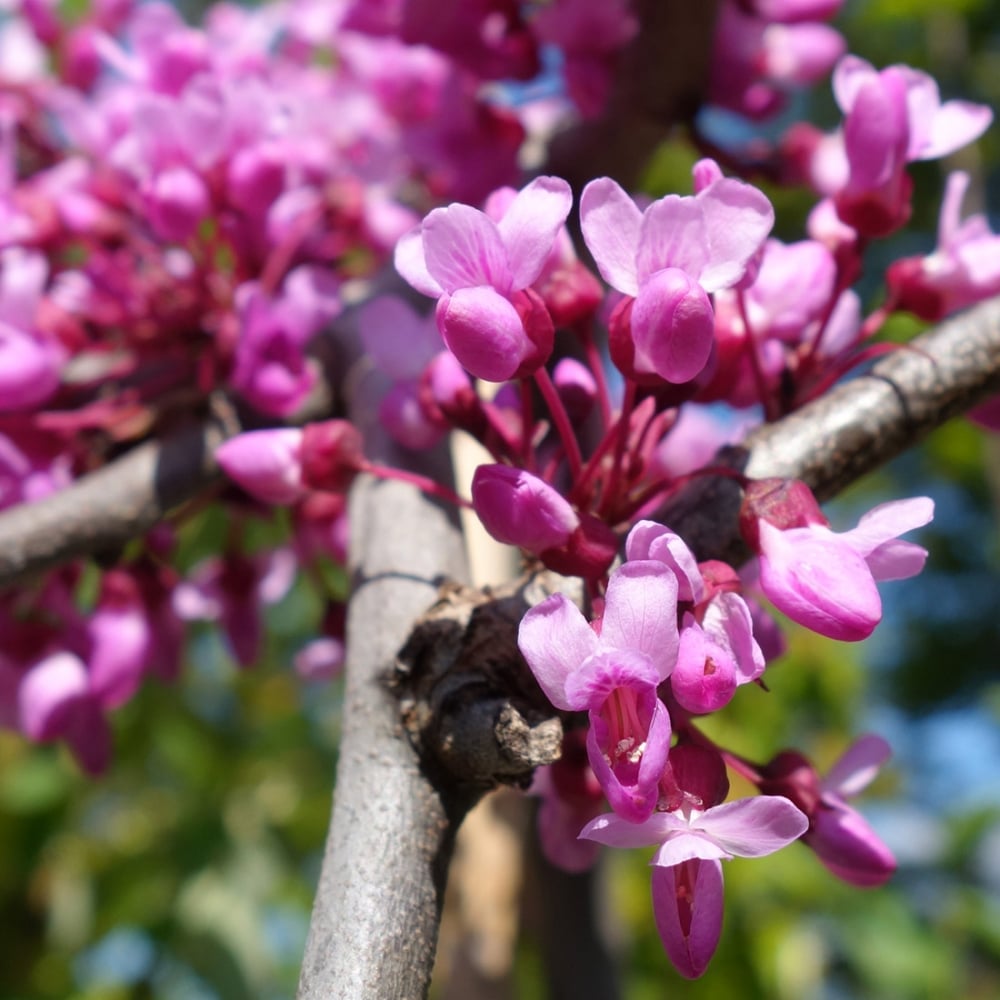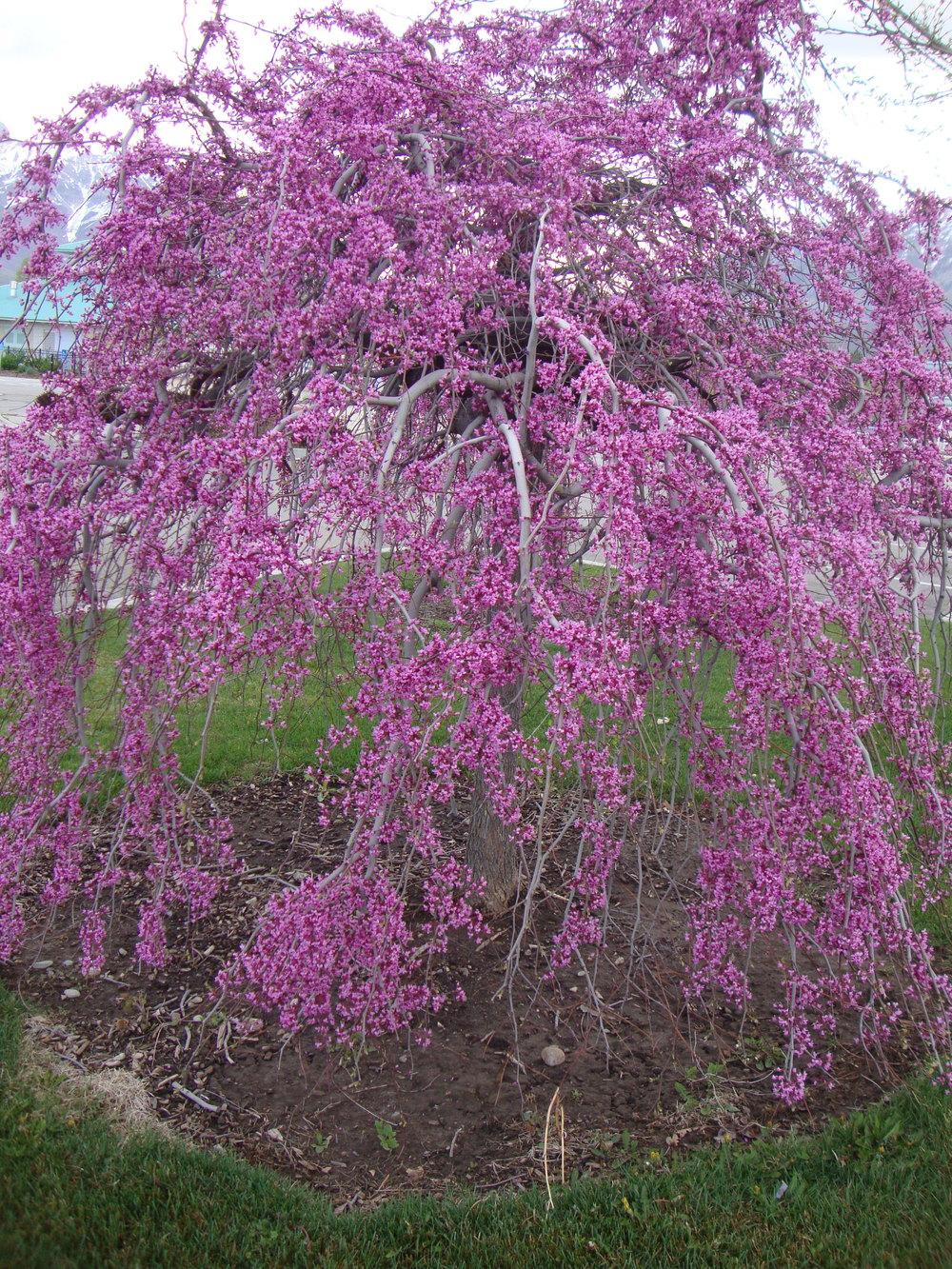
Cercis canadensis Lavender Twist Covey Eastern Redbud Trees
eastern redbud [Lavender Twist] a slow-growing selection; a compact tree with a weeping habit. Heart-shaped leaves appear after flowering and produce good, yellow autumn colour. Large flower clusters of lavender, pea-like flowers are borne on bare stems in spring Synonyms Cercis canadensis 'Covey' Cercis canadensis 'Lavender Twist'

Cercis canadensis Lavender Twist Eastern redbud, Weeping eastern redbud, Dobbies Garden
The eastern redbud is native to the eastern U.S. and northeastern Mexico. It is commonly grown as an ornamental tree for its heavy crop of pink to white flowers in early spring.. Variety 'Lavender Twist' is a horticultural selection with drooping branches. It droops so strongly that it must be staked when young to develop an upright trunk.

Cercis canadensis ‘Covey’ Lavender Twist Weeping Eastern Redbud Doty Nurseries
Lavender Twist Redbud Cercis canadensis 'Covey' 0 reviews This product is currently out of stock and unavailable. Notify me when available Related Products Forest Pansy Redbud $109.50 - $149.50 Eastern Redbud Tree $109.50 Cascading Hearts Redbud Tree $149.50 Cotton Candy® Redbud Tree $159.50 30 day - ARRIVE AND THRIVE™ guarantee Learn more

Photo of the bloom of Eastern Redbud (Cercis canadensis var. canadensis Lavender Twist®) posted
Lavender Twist Redbud is a stunning ornamental tree that adds a touch of elegance and beauty to any landscape. With its unique weeping form and captivating lavender-pink flowers, it creates a focal point that instantly grabs attention.. Another pest to watch out for is the caterpillar of the Eastern tent caterpillar moth. These caterpillars.

Cercis canadensis 'Lavender Twist' Eastern Redbud The firs… Flickr
Looking for Lavender Twist Redbud? We have almost everything on eBay. But did you check eBay? Check Out Lavender Twist Redbud on eBay.

Cercis canadensis Lavender Twist Covey Eastern Redbud Trees
FeaturesAn enchanting weeping form of the popular Redbud tree. Produces a cascade of twisted, weeping branches covered with lavender-pink blooms in spring and layers of lovely heart-shaped foliage through the summer. Small clusters of flat seed pods appear in autumn and persist well into winter. This is a terrific little tree for small spaces. U.S. Plant Patent #10,328.UsesA charming specimen.

Photo of the bloom of Eastern Redbud (Cercis canadensis var. canadensis Lavender Twist®) posted
Hardiness Zone: 5-9 · Mature Height: 6-10 Feet · Mature Spread: 4-6 Feet. Buy Lavender Twist™ online. Is an amazing plant originally found in Westfield, New York. In spring clusters of magenta buds open to rosy-pink flowers born on branches that are both pendulous and weeping. Zigzagging branches form a cascading fall of rich green heart.

Cercis canadensis ‘Covey’ Lavender Twist Weeping Eastern Redbud Doty Nurseries
Lavender Twist redbud is a dwarf variety, slowly growing 5 to 15 feet (1.5-5 m.) tall and wide. Its unique attributes include the pendulous, weeping habit and contorted trunk and branches. Like the common eastern redbud, Lavender Twist redbud trees bear small, pea-like pink-purple flowers in early spring, before the tree leafs out.

Cercis canadensis 'Covey' Lavender Twist® Lavender Twist® eastern redbud The Dawes Arboretum
The weeping redbud known as "Lavender Twist" was discovered in 1991 in western New York state. The gardener's last name is Covey and so the tree is sometimes also known as the "Covey Eastern Redbud". It was patented in 1998 and is now more widely available.

Photo of the entire plant of Eastern Redbud (Cercis canadensis var. canadensis Lavender Twist
Lavender Twist Weeping Redbud trees bloom really early in the spring and unlike Weeping Cherry trees, the flowers are pretty doggone tough. I've seen them go through frost after frost without fazing the blooms at all. That's a huge advantage for a tree that blooms early in the spring.

Cercis canadensis Lavender Twist Covey Eastern Redbud Trees
Plant database entry for Eastern Redbud (Cercis canadensis var. canadensis Lavender Twist®) with 15 images and 27 data details. Learning Library. Eastern Redbud (Cercis canadensis var. canadensis Lavender Twist®) General Plant Information ; Plant Habit: Tree: Life cycle: Perennial: Sun Requirements: Full Sun to Partial Shade: Water.

Photo of the entire plant of Eastern Redbud (Cercis canadensis var. canadensis Lavender Twist
Lovely Lavender Twist®, sometimes called 'Covey,' is a dwarf, weeping redbud cultivar that lends itself perfectly to small gardens or even containers. Tim Brotzman of Brotzman's Nursery in Madison, Ohio, bred the stunner after he was sent some scions of an unusual weeping redbud.

Cercis canadensis 'Lavender Twist' Weeping Eastern Redbud Picture courtesy of Progressive Plants
Explore Your One-Stop-Shop For All Your Requirements. Shop Online Today! Amazon Offers an Array Of Unique Products From Thousands Of Brands.

Cercis canadensis ‘Covey’ Lavender Twist Weeping Eastern Redbud Doty Nurseries
Perfect for small gardens, Cercis canadensis Lavender Twist (Eastern Redbud) is a small, weeping, deciduous tree with multiple seasons of interest. A profusion of pea-like lavender-pink flowers held in clusters cover the bare cascading branches for several weeks in the spring, before the foliage emerges, creating a most dramatic display.

Photo of the entire plant of Eastern Redbud (Cercis canadensis var. canadensis Lavender Twist
Description Eastern redbud is a deciduous, ornamental tree in the Fabaceae or pea family. It is native to eastern North America and may grow up to 20 or 30 feet tall. and 20-35 feet wide. it is a smaller tree with a nearly flat or rounded crown that is often found growing beneath taller trees.

Cercis canadensis ‘Covey’ Lavender Twist Weeping Eastern Redbud Doty Nurseries
The Lavender Twist Redbud, also known as the 'Covey' eastern redbud, traces its origins to a private garden in Westfield, N.Y., discovered by Connie Covey in 1991. After cuttings were taken for propagation by horticulturists, the plant earned its patent in 1998.